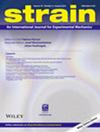电子散斑干涉法对混凝土断裂过程区的实验研究
IF 2.4
3区 材料科学
Q2 MATERIALS SCIENCE, CHARACTERIZATION & TESTING
引用次数: 3
摘要
为了加深对混凝土断裂破坏机制的理解,对预缺口试件进行了一系列三点弯曲试验,以研究断裂过程区的特征。采用电子散斑干涉法(ESPI)确定裂纹的位置和尺寸。实验结果表明,当荷载增加到峰值荷载(Pmax)的40%时,预制缺口混凝土梁中的裂缝将开始,并在达到峰值荷载后不稳定扩展。当载荷在载荷下降段下降到约25%Pmax时,形成了完整的断裂过程区(FPZ),相应的裂纹尖端张开位移约为临界裂纹尖端张开变形的7.1倍。对混凝土试件表面应变的分析表明,当混凝土表面拉应变达到2左右时,就会产生微裂纹 × 10−4;当混凝土表面拉伸应变值达到4时 × 10−2,FPZ将向前移动;混凝土的FPZ的长度在整个断裂过程中基本保持不变,约为韧带高度的71%。试验数据分析还表明,混凝土立方体抗压强度对FPZ的尺寸影响不大。此外,采用增量位移配置法最终确定了试件的拉伸软化曲线,得出FPZ的临界宽度与混凝土的立方体抗压强度有关的结论。本文章由计算机程序翻译,如有差异,请以英文原文为准。
Experimental investigation on the concrete fracture process zone using electronic speckle pattern interferometry
In order to advance the understanding of fracture failure mechanisms in concrete, a series of three‐point bend tests of pre‐notched specimens were conducted to study the characteristics of the fracture process zone. Electronic speckle pattern interferometry (ESPI) was used to determine the location and size of the cracks. The experimental results have shown that crack in the pre‐notched concrete beams will initiate when the load increases to 40% of the peak load (Pmax) and expands unstably after reaching the peak load. When the load drops to about 25% Pmax in the load drop section, a complete fracture process zone (FPZ) was developed, and the corresponding crack tip opening displacement is about 7.1 times to the critical crack tip opening displacement. The analysis of surface strain of concrete specimen showed that microcracks will initiate when the surface tensile strain of concrete reaches about 2 × 10−4; when the surface tensile strain value of concrete reaches 4 × 10−2, the FPZ will move forward; the length of the FPZ of concrete essentially remains the same in the entire fracture process, which is about 71% of the ligament height. The analysis of experimental data also shows that the size of the FPZ is not significantly affected by the cubic compressive strength of concrete. In addition, the tension‐softening curves of the specimens were finally determined by using the incremental displacement collocation method, and it is concluded that the critical width of the FPZ is related to the cubic compressive strength of the concrete.
求助全文
通过发布文献求助,成功后即可免费获取论文全文。
去求助
来源期刊

Strain
工程技术-材料科学:表征与测试
CiteScore
4.10
自引率
4.80%
发文量
27
期刊介绍:
Strain is an international journal that contains contributions from leading-edge research on the measurement of the mechanical behaviour of structures and systems. Strain only accepts contributions with sufficient novelty in the design, implementation, and/or validation of experimental methodologies to characterize materials, structures, and systems; i.e. contributions that are limited to the application of established methodologies are outside of the scope of the journal. The journal includes papers from all engineering disciplines that deal with material behaviour and degradation under load, structural design and measurement techniques. Although the thrust of the journal is experimental, numerical simulations and validation are included in the coverage.
Strain welcomes papers that deal with novel work in the following areas:
experimental techniques
non-destructive evaluation techniques
numerical analysis, simulation and validation
residual stress measurement techniques
design of composite structures and components
impact behaviour of materials and structures
signal and image processing
transducer and sensor design
structural health monitoring
biomechanics
extreme environment
micro- and nano-scale testing method.
 求助内容:
求助内容: 应助结果提醒方式:
应助结果提醒方式:


